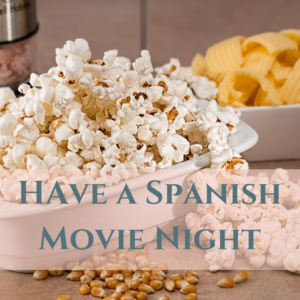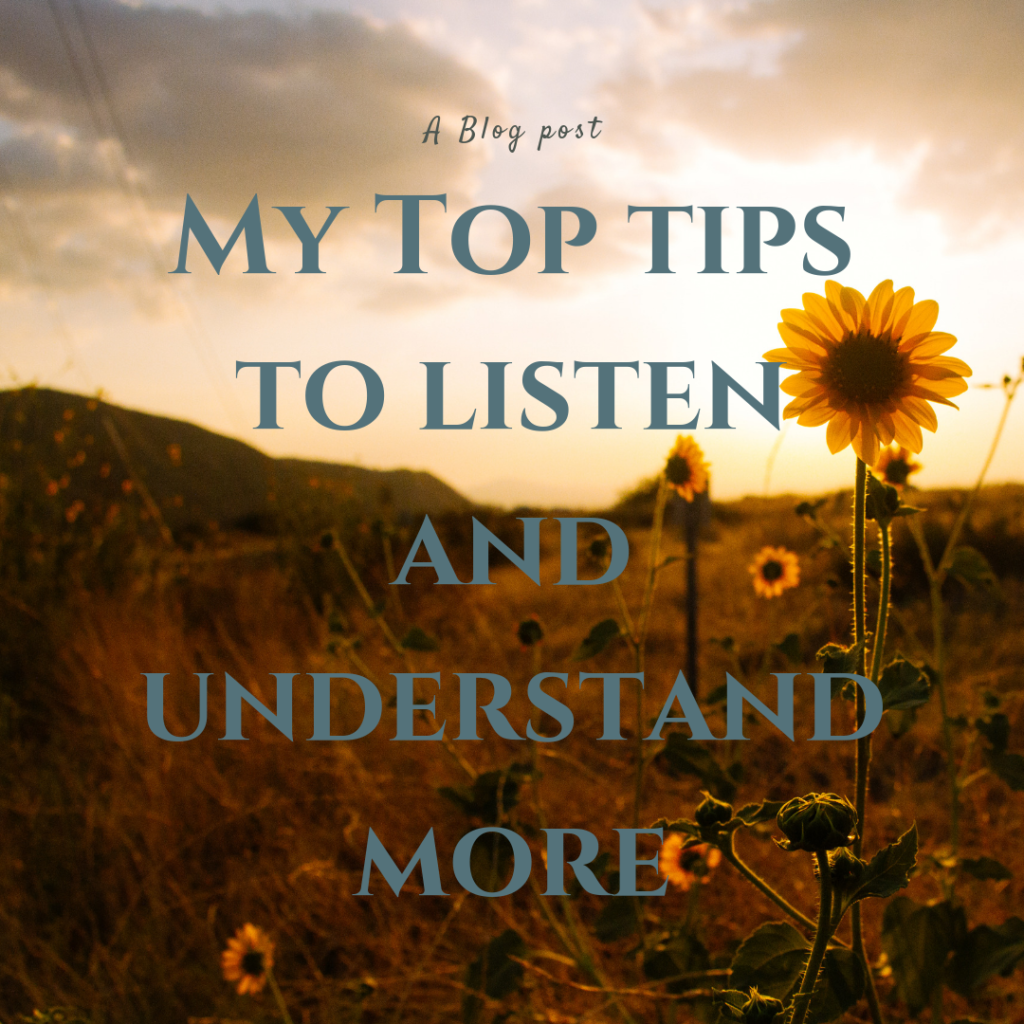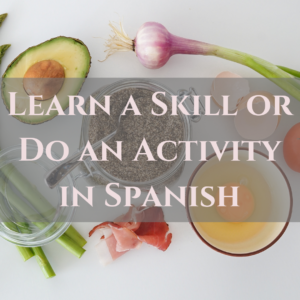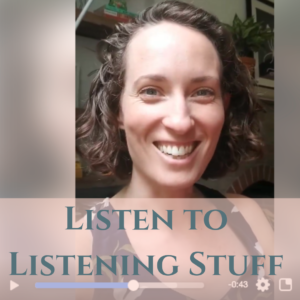I will admit to you that there was a not insignificant period of time when I would converse in Spanish … you know, I would say something to someone else and be so proud of what came out of my mouth, and then … and then that someone else would answer back.
At times I wasn’t entirely sure I understood them.
Then there were times I was absolutely sure that I didn’t understand them.
So what is an aspiring Spanish-speaker to do?
Ha. If you see yourself in this story, or if you know this could be you when you start conversing in Spanish more, then you. are. not. alone.
Developing your listening ability is such a normal part of the process that it is literally an entire “domain” that is assessed in language acquisition assessments (all four include Listening, Speaking, Reading, and Writing).
Listening can develop in different stages, but for most people who live in an English-speaking country who engage in formal Spanish training at some point (especially if that was in school), listening can be a sticky domain.
In class, you learn to read and write. You can fill in the blanks like a pro. You can conjugate verbs, you know the words for the items in your kitchen … but listening is a different story.
Why is it so hard to just listen?
Apart from just not getting much practice in traditional classes, listening is made still more complex in the real world, where different people have different accents, different mannerisms, and different quirks. Some speak fast and others slow. Some use slang and others use more “proper” Spanish. When you are trying to get your feet wet, it can be a challenge!
So it is no surprise that many of my students have asked me for recommendations for how to practice their listening skills. Then I flashback to hours in the Language Lab at Georgetown, with my big fat headset on, listening to outdated sports or news coverage in Spanish … and my commitment to never put you through that is instantly renewed. You’re welcome. 😉
That being said, it is still definitely a good thing to practice your listening. And it can help to do it in a low-stakes environment when you’re not in the throes of a conversation, staring like a deer in headlights when the other person speaks.
So I have put together a few tips and tricks that I recommend to spice up your Spanish listening in a way that can be enjoyable and enrich your life beyond just Spanish!
So here are my BEST Tips and Tricks for Listening Better and Understanding More in Spanish:
1. watch Spanish language music videos on youtube… with closed captions.
Just try a song, and in the bottom right-hand corner, click the “CC” or closed captions button so you can read along while you listen. Not every song will have this option, but the highly produced music videos often will. Some of my favorites, from slowest speech to fastest are:
-
-
- Luz Pinos: Mozo is entertaining
- Calle 13: La Vida has closed captions. (The words are pretty fast, though)
- Jósean Log: He does a lot of lyric videos like Chachachá, Jacaranda, and Contento de Contento
- Juanes: Check out La Plata
- Latinoamérica by Calle 13 doesn’t have captions paired with it, but it is a beautiful song and a beautiful video, and the song is pretty slow and clear. When I used to teach Zumba classes, this was my favorite cool-down song. (The second round of the chorus is in portuguese, so don’t think you’re crazy when you don’t understand.)
- If you’re a Shakira fan, some of her Spanish songs have closed captions, like Perro Fiel. (“Perro Fiel”, by the way, means “Faithful Dog”. Romantic, huh?)
-
2. Learn a new skill or do an activity in Spanish on Youtube!
Just search for the Spanish word or phrase, and then have a blast. For example …
- If you want to work out, and you can do something at home, search in youtube “ejercicio” for “exercise” and choose a video that looks good, such as this “cardio intenso” video.
- If you’re a yogi, you can do the same thing. However, typing in “yoga” probably won’t get you many Spanish videos since the word is the same in both languages. Instead, try something like “hacer yoga” or “rutina de yoga” and you will find videos like this one.
The benefits of using this strategy are that you get a visual along with the instructions, AND if you do the activity along with the video, you are triggering yet more connections in your brain to internalize what you are hearing.
Don’t worry if you don’t understand all the words. The point is that you are hearing language, following along, and your brain, over time, will make meaning.
- If you cook, try following a recipe!
Maybe you want to make paella (hello, Spanish accent), tacos de pollo (I love this lady, plus she speaks slowly and clearly). or something that’s hard to screw up even if you don’t understand the Spanish like guacamole (this one is quite entertaining and also breaks down the words for the ingredients).
If any of these videos seem too difficult, this is what you do:
Look up a video teaching you to cook something you already know how to make.
Even though you still might feel like you don’t understand, since your brain can focus on the language only and not on the food as well, it can focus in and listen for the words it expects to hear. Do this once or twice a week and you’ll start to pick things up after a while.
-
- First type in “receta para [insert food]” or “cómo preparar [insert food]”. If you like one of these, you can subscribe to their channel and
- You can do this with anything! Learn how to sew (coser), arrange flowers (arreglar flores), or clean the stovetop (limpiar la estufa)!
3. Listen to something designed just for listening!
- If you are a beginner, join my Facebook group, Spanish Help for Committed Teachers, and listen to my 2-minute beginner listening videos.
I developed these because when my Spanish students said that the podcast I am about to recommend below was too difficult, I couldn’t find a listening resource for beginners that I that was very useful! So, story of my life … if it doesn’t exist, make it.
- If you are approaching intermediate or at any point beyond that, listen to Duo Lingo’s Spanish Podcast.
I love, love, love this podcast. It is real stories about real people that are told in a truly artful way and suck you into the story just like This American Life, The Moth, or any other great storytelling podcast.
The host co-narrates with each Spanish-speaking guest. Yet she catches you up, gives you context, and sometimes even teaches you a word you’re about to hear by speaking in English.
That way, even if you don’t understand every single thing, you won’t get completely lost, and will certainly learn along the way. I can’t recommend this podcast enough.
- If you are advanced, listen to TED en Español.
This is a great resource to develop your listening as well. It is definitely challenging, including for me. But if you want to push your Spanish to the next level, it is just what the doctor ordered. The last one I listened to was someone’s talk about what their experience being held hostage by FARC in Colombia for several years taught her. Intense! But oh so good.

4. Have a Spanish movie night!
I know you’ve heard this one before. But here’s the key:
Unless you consider yourself very advanced in which case you are probably not reading my blog … watch the Spanish movie with Spanish subtitles.
That’s right. Not English subtitles. Not no subtitles. Spanish subtitles.
This is very important to making connections between the reading skills you already have and what your ear hears. Often times, especially when hearing something out of context or novel, our native English brains don’t know how to make sense of the sounds we hear even if we know the words.
Where does one word end and the next begin?
Did he just say “Take my french fries for a walk this morning”???
It can be quite frustrating, and for this reason, not a lot of Spanish learners make it through a whole movie if they even sit down to watch it in the first place.
My favorites are Motorcycle Diaries (Diarios de Motocicleta) and Como Agua Para Chocolate, but the reason I put this last is that I am still working on where you can get these movies in their entirety in Spanish AND with Spanish subtitles short of buying the DVDs themselves, although you could definitely do that. (Como Agua Para Chocolate is hard to find in Spanish with Spanish subtitles. Here it is with English subtitles. And in the meantime, I will keep looking.)
You can also find movie clips on youtube and watch with closed captions there, too. Just remember to click the “CC” button when you watch!




